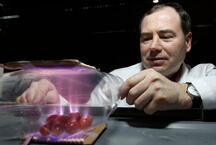In-package plasma process quickly, effectively kills bacteria
April 16, 2013
 |
|
Kevin Keener is developing methods using cold plasma to kill
bacteria on in-package foods. (Tom Purdue Agricultural Communication file
photo/Tom Campbell)
|
WEST LAFAYETTE, Ind. - Exposing packaged liquids, fruits and vegetables to an electrical field for just minutes might eliminate all traces of foodborne pathogens on those foods, according to a Purdue University study.
Kevin Keener, a professor of food science, looks for new ways to kill harmful bacteria, such as E.coli and Salmonella, that contaminate foods and cause serious illnesses and deaths. His method uses electricity to generate a plasma, or ionized gas, from atmospheric gases inside the food package.
This process creates a wide variety of bacteria-killing molecules including ozone, nitrogen oxides, hydrogen peroxide and others. These molecules only exist for a few hours and then revert back to the original atmospheric gas, leaving a bacteria-free product.
In findings published in the Journal of Applied Microbiology, Keener and researchers at the Dublin Institute of Technology demonstrated that sealed-package atmospheric plasma works well to kill bacteria in growth media. Their experiments showed that bacteria on these surfaces were eliminated with 20 seconds of treatment and 24 hours of exposure to the gases it creates. Keener said the cost of the process should be comparable to current chemical and heat treatments used to sanitize foods.
"Even in the most resistant bacteria-growing media, 45 seconds of treatment gave us complete elimination of the E. coli," Keener said. "Under a microscope, we saw holes forming in the cell walls of the bacteria."
Adapting the technology for liquids could allow development of portable devices to clean drinking water in areas with contamination or that lack other purification methods. It could also allow food processors to bottle juices without first heating them, a process widely used to kill bacteria that can alter products.
"This could be developed to allow you to achieve something similar to pasteurization without the heat and quality changes that occur with that process," Keener said.
In Europe, especially, new methods are being sought as alternatives to washing foods in chlorine baths.
"Chlorine water works well on hard surfaces. But there can be issues if bacteria get inside organic matter on the produce, making chlorine ineffective," Keener said.
Keener is working with researchers at Dublin Institute of Technology, National Centre for Plasma Science and Technology at Dublin City University in Ireland, and Innovació i Recerca Industrial i Sostenible (IRIS) in Spain to develop a precommercial system for larger-scale decontamination testing. After that, he would like to build a commercial system that could be used in food-processing plants.
Future research will also consider how the process affects food quality.
"Results from recent testing of E. coli bacteria in liquid suspensions demonstrated significant bacterial reductions with no heating or visual color change." Keener said. "This suggests that atmospheric cold plasma treatment may achieve a cold pasteurization process for liquid foods to extend shelf-life and improve safety."
The European Community's Seventh Framework program funded the research. These results are part of a larger EU project entitled SAFE-BAG. More information can be found at http://www.safebag-fp7.eu/
Writer: Brian Wallheimer, 765-496-2050, bwallhei@purdue.edu
Source: Kevin Keener, 765-494-6648, kkeener@purdue.edu
VIDEO:
Atmospheric Cold Plasma - http://www.youtube.com/watch?v=HPcsTav95nc&feature=youtu.be
EMBED CODE: <iframe width="560" height="315" src="http://www.youtube.com/embed/HPcsTav95nc" frameborder="0" allowfullscreen></iframe>
ABSTRACT
Atmospheric Cold Plasma Inactivation of Escherichia coli in Liquid Media Inside a Sealed Package
D. Ziuzina, S. Patil, P.J. Cullen, K. M. Keener, P Bourke
Aims: The main objective of this study was to determine the inactivation efficacy of dielectric barrier discharge atmospheric cold plasma (DBD-ACP) generated inside a sealed package for Escherichia coli ATCC 25922.
Methods and Results: A plasma discharge was generated between two circular aluminium electrodes at 40 kV. E. coli suspensions (107 CFU ml−1) in either maximum recovery diluent (MRD) or phosphate buffered saline (PBS) were treated in a 96-well microtitre plate inside a sealed package. The effects of treatment time, post-treatment storage time, either direct or indirect samples exposure to the plasma discharge and suspension media were studied. Regardless of the media tested, 20 s of direct and 45 s of indirect plasma treatment resulted in complete bacterial inactivation (7 log CFU ml−1). At the lower plasma treatment times (10–30 s) investigated, the effects of suspension media and mode of exposure on the inactivation efficacy were evident. The inactivation efficacy was also influenced by the post-treatment storage time.
Conclusions: It was demonstrated that the novel DBD-ACP can inactivate high concentrations of E. coli suspended in liquids within sealed packages in seconds.
Ag Communications: (765) 494-2722;
Keith Robinson, robins89@purdue.edu
Agriculture News Page

